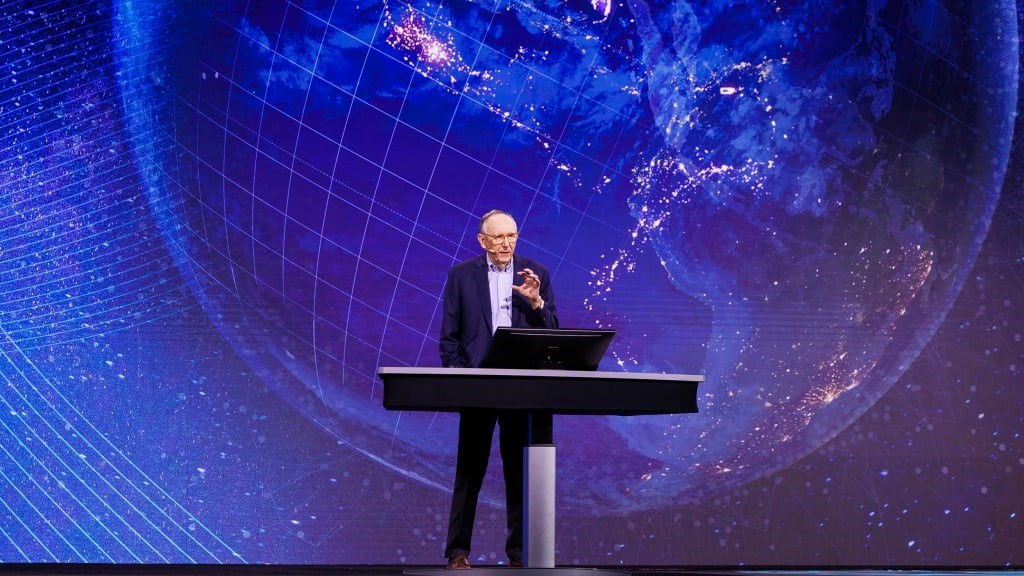The company that helped put Tim Walz on the map offers a master class in building an enduring business
The company that helped put Tim Walz on the map offers a master class in building an enduring business
Esri, the maker of geographic information system software, has never had a layoff. Here’s their secret.
Hello and welcome to Modern CEO! I’m Stephanie Mehta, CEO and chief content officer of Mansueto Ventures. Each week this newsletter explores inclusive approaches to leadership drawn from conversations with executives and entrepreneurs, and from the pages of Inc. and Fast Company. If you received this newsletter from a friend, you can sign up to get it yourself every Monday morning.
In July, a few weeks before Vice President Kamala Harris picked Minnesota Governor Tim Walz as her running mate in the presidential election, Walz delivered a spirited speech about the power of maps to a group of analysts, data scientists, software developers, and other professionals in the geospatial field. The presentation helped cement the former geography teacher’s reputation as a “map nerd” who has used mapping software to help drive his legislative agenda.
Walz’s remarks also shone a spotlight on Esri, the maker of geographic information system (GIS) software and the host of the event where Walz spoke. Founded in 1969 by Jack and Laura Dangermond, the company is well-known among those who use, make, and analyze maps. This cohort includes infrastructure, engineering, supply chain, and education experts in industries ranging from conservation and humanitarian assistance to petroleum and defense. The company is less prominent in broader business circles, perhaps because it has avoided headline-grabbing events like layoffs, venture capital raises, and IPO road shows.
Purpose over pomp

That’s a shame, because while unflashy, CEO Jack Dangermond’s quiet approach offers a case study in building a sustainable enterprise. “I’m not criticizing other companies and how the business world works, but Esri is unique in the sense that we can focus on advancing the tools and the methods and on serving our users,” Dangermond says. “The number-one focus that we think a lot about here and talk about in all our meetings is our users—not our stockholders, but our users.”
To be sure, Dangermond didn’t start Esri (short for Environmental Systems Research Institute) with the aim of building an enduring business. He and Laura, who worked together at a Harvard University computer mapping and spatial analysis lab, were looking for a way to turn their love of maps and systems analysis into a paying gig after graduation. They returned to Dangermond’s hometown of Redlands, California, and began doing environmental projects and assessments. “There was no great vision,” he says with a light laugh.
Lessons in purposeful growth
After a decade or so of project work using computer-based mapping, Esri began selling its software to clients. Dangermond says his decision to bootstrap the business is rooted in values he learned working in his family’s plants nursery, which he says didn’t take on debt and always paid its bills on time. “Laura and I didn’t come from money, and we were very conservative,” he says. “We never borrowed money, and we weren’t interested in go-go growth.”
Nonetheless, Esri did experience rapid growth, fueled in part by an explosion of data from transactions, sensors, Internet of Things, and other networked and connected devices. Esri’s enterprise platform helps organizations visualize and analyze that data. Companies can track supplies in their network in real time, use maps and sensors to manage natural resources, or use the technology to select sites for stores or warehouses. Esri’s ArcGIS platform helped power the Johns Hopkins COVID-19 Dashboard, a key source of information during the pandemic.
But rather than seek outside investment as many software companies do, Esri has self-funded its growth, and Dangermond says the company invests 30% of revenue in research and development (R&D). “For 40 years, we’ve taken any spare money and poured it into innovation,” he says. For comparison, software companies typically invest about 20% of revenue in R&D. Esri, which is privately held, doesn’t disclose revenue, but Dangermond said the company has “a couple billion” in annual sales.
Concentrate on the core
Dangermond says Esri isn’t planning to build applications that overlap or compete with its customers, which include Microsoft, Salesforce, and Autodesk. “We’re not greedy. We’re interested in partnering to empower other tech companies,” he says. “We can create a much bigger ecosystem of impact by just concentrating on our core.”
While speaking with Dangermond, I was reminded of a conversation I had with author Jim Collins a few years ago. Collins is best known for books such as Built to Last and Good to Great, but his first book was Beyond Entrepreneurship, aimed at helping founders turn their businesses into enduring companies. He reissued the book in late 2020, and we spoke about the frameworks entrepreneurs should apply in building what Collins defines as great companies.
Esri checks a lot of Collins’s boxes: It invests in itself; it plays a leadership role in its industry; and it cultivates a strong reputation with customers. But it is Esri’s philosophy around its impact that feels especially aligned with the way Collins talks about enduring businesses. “If you’re going to do something entrepreneurial, then you should set out to try to create something truly worthy of lasting,” Collins told me. “There are people who have built these companies that are worthy of admiration that have had an impact on the world. That’s the standard that you should aspire to.”
Are you building an enduring company?
Is your organization “built to last”? How do you ensure that your company has an impact? Send your insights and stories to me at stephaniemehta@mansueto.com. I’d love to share examples in a future newsletter.
Read and listen: enduring enterprises
- Jim Collins on building companies to last
- This 169-year-old company can teach us a lot about stakeholder capitalism
- The Acquired podcast on the history and strategy of Nintendo
ABOUT THE AUTHOR
(4)



